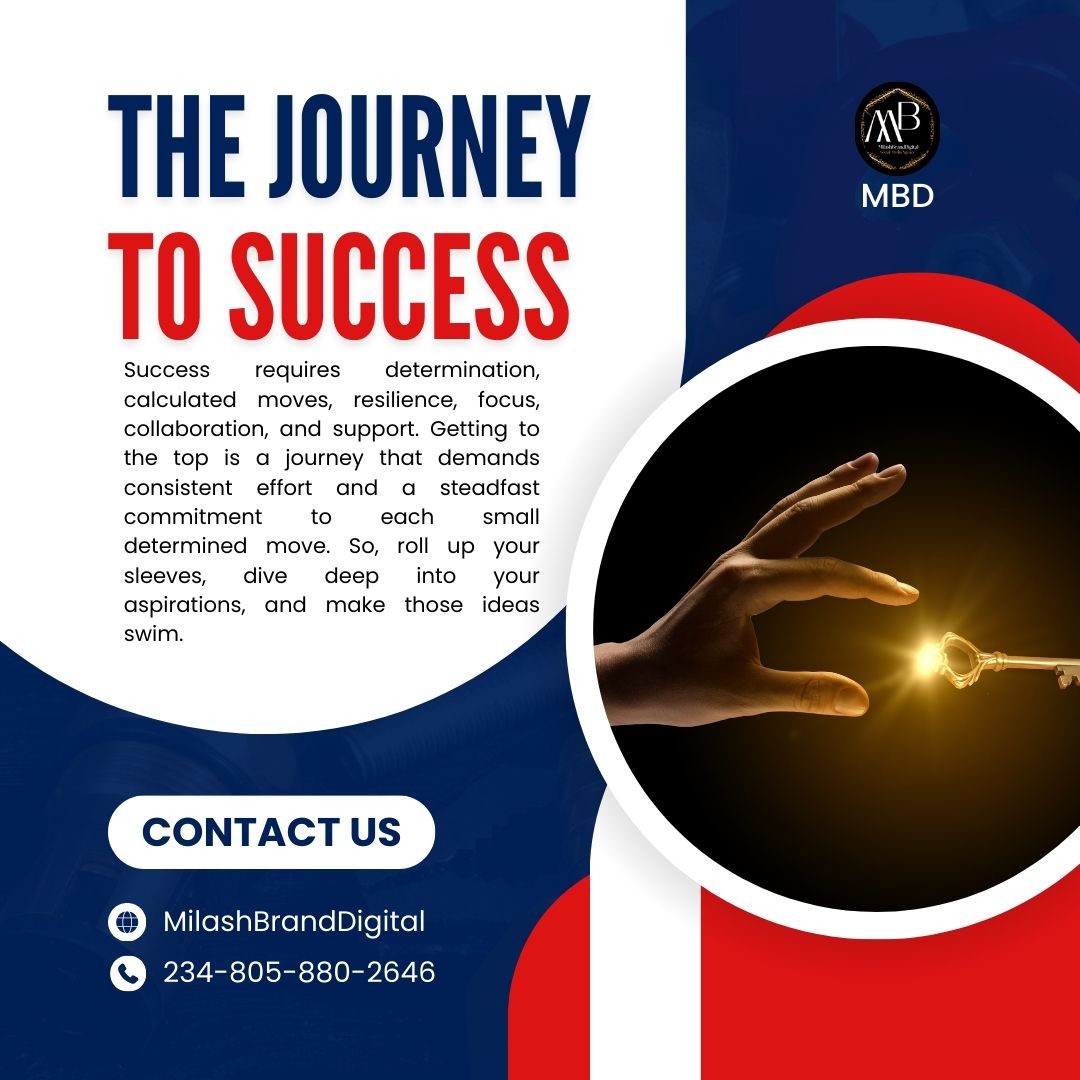We are committed to developing impactful marketing strategies and innovative campaigns that captivate audiences and foster meaningful customer engagement. With our unique brand storytelling skills, we communicate your brand message and spread the gospel of your brand to a global audience.
Tuesday, February 6, 2024
DEVELOPING SELF-AWARENESS AND EMOTIONAL INTELLIGENCE AS A LEADER
Monday, February 5, 2024
DEVELOPING LEADERSHIP SKILLS AT ALL LEVELS
Sunday, February 4, 2024
LEADING FROM THE MIDDLE: MANAGING UP AND DOWN EFFECTIVELY
Wednesday, January 17, 2024
CUSTOMER EXPERIENCE: THE GAME-CHANGER FOR BRANDS
Tuesday, January 16, 2024
BOOSTING TEAM BUILDING: IGNITING ENTHUSIASM AND ACHIEVING SUCCESS
Monday, January 15, 2024
DISCOVER THE POWER OF EDITING ASSOCIATIONS AND EMBRACING CHANGE FOR PERSONAL GROWTH
Sunday, January 14, 2024
The IMPORTANCE OF BUSINESS ETHICS: BUILDING TRUST IN THE MODERN MARKET
Discover the importance of business ethics in building trust and success. Learn how to implement ethical practices that enhance your reputation and create a sustainable future. Join the ethical revolution today!
Success hinges on more than just providing a quality product or service. Building trust with customers, clients, and stakeholders is crucial for long-term success. Gone are the days of traditional trust-building; now, success is crafted by baking honesty and transparency custards into the business pie. The business mantra of today: infuse honesty and transparency into every layer of your trust-flavored pie for a recipe that withstands the challenges of the modern market.
What are Business Ethics?
Business ethics refer to the moral principles and values that guide behavior in the business world. It encompasses honesty, integrity, fairness, and accountability in all aspects of business operations. At its core, business ethics is about doing the right thing, even when it may not be the most profitable or convenient choice.
Why are Business Ethics Important?
Building Strong Relationships: Businesses that prioritize ethics can build strong relationships with customers, employees, and stakeholders. When customers trust a company, they are more likely to become repeat customers and even recommend the business to others.
Enhancing Reputation: Ethical behavior contributes to a positive reputation. A strong reputation attracts new customers and business opportunities, while a tarnished reputation can be difficult to recover.
Employee Morale and Loyalty: Employees are more likely to be loyal and motivated when they work for a company that upholds ethical standards. This leads to higher productivity, better teamwork, and reduced turnover.
Risk Mitigation: Ethical business practices help mitigate legal and financial risks. By operating within the boundaries of the law and adhering to ethical principles, companies can avoid costly legal battles and negative publicity.
Long-Term Sustainability: Businesses that prioritize ethics are more likely to create sustainable models that benefit both the company and society. By considering the environmental and social impact of their operations, businesses can contribute to a better future.
How to Implement Business Ethics?
Ethical Leadership: It starts at the top. Leaders must set an example by demonstrating ethical behavior and creating a culture that values integrity and accountability.
Clear Ethical Guidelines: Companies should establish clear ethical guidelines that outline expectations and provide guidance on ethical decision-making.
Training and Education: Employees need to understand the importance of business ethics and how to apply ethical principles in their day-to-day work. Regular ethics training ensures that ethical behavior becomes ingrained in the company's culture.
Reward Ethical Behavior: Recognize and reward employees who demonstrate ethical behavior. This reinforces the importance of ethics and encourages others to follow suit.
Ethical Supply Chain Management: Ensure that suppliers and partners also adhere to ethical standards. This includes fair labor practices, environmental responsibility, and ethical sourcing.
Transparency and Communication: Foster a culture of open communication and transparency. This helps build trust among employees, customers, and stakeholders.
Conclusion
In a world where information spreads at lightning speed, businesses can no longer afford to ignore the importance of ethics. By infusing honesty and transparency into every aspect of their operations and decision-making processes, businesses can build trust, enhance their reputation, and create a sustainable future. Remember, success in the modern market requires a strong ethical foundation. So, are you ready to bake a trust-flavored pie that withstands the test of time?
Friday, January 12, 2024
WHAT RULES ARE GUIDING YOUR ORGANIZATION?
The Importance of Company Culture in Business Success
Defining Company Culture
Company culture refers to the shared values, beliefs, attitudes, and behaviors that characterize an organization. It encompasses everything from the company's mission and vision to its working environment and employee interactions. It defines the way things are done within the organization and influences the mindset and attitudes of its employees.
The Impact of Company Culture
A strong and positive company culture can have a profound impact on an organization's success. Here's how:
Attracting and Retaining Top Talent
Attracting and retaining top talent is a constant challenge. A strong company culture acts as a magnet, drawing in skilled professionals who value a positive and inclusive work environment. When employees feel a sense of belonging and fulfillment, they are more likely to stay loyal to the organization, reducing turnover and recruitment costs.
Driving Employee Engagement
Employee engagement is essential for productivity and business success. A positive company culture fosters a sense of purpose, engagement, and commitment among employees. When employees are happy and engaged in their work, they are more willing to go the extra mile, be proactive, and contribute positively to the organization's goals.
Enhancing Collaboration and Teamwork
A healthy company culture promotes collaboration and teamwork, breaking down silos and encouraging open communication. Employees feel supported and valued, leading to better cooperation and innovation. Collaboration is vital for problem-solving, driving creativity, and achieving significant results.
Improving Performance and Productivity
When employees are motivated, inspired, and aligned with the company's goals and values, their performance and productivity levels skyrocket. They are more likely to take ownership of their work, deliver high-quality outcomes, and exceed expectations. A positive company culture provides the necessary support, recognition, and rewards to fuel employee performance.
Boosting Customer Satisfaction
Company culture extends beyond internal dynamics. It influences how employees interact with customers and the level of customer service they provide. When employees are happy, engaged, and aligned with the company's values, they are more likely to deliver exceptional customer experiences, resulting in higher customer satisfaction and loyalty.
Building a Strong Company Culture
Creating a strong and positive company culture requires a deliberate and strategic approach. Here are some key steps to building an effective company culture:
Define Core Values and Mission
Start by defining the core values and mission that align with your organization's vision. These values should guide everything your company does, from hiring decisions to daily operations. Communicate these values clearly and consistently to all employees.
Lead by Example
Company culture starts at the top. Leaders must embody the desired culture and set an example for others to follow. Their actions, decisions, and behaviors should reflect the core values and mission, creating a culture of trust, respect, and integrity.
Foster Open Communication
Promote open and transparent communication within the organization. Encourage feedback, ideas, and suggestions from employees at all levels. Active listening and effective communication build trust and strengthen relationships.
Recognize and Reward
Recognize and reward employees who demonstrate the desired values and behaviors. Celebrate achievements and milestones, creating a culture of appreciation and encouragement. Recognizing and rewarding employees not only boosts morale but also motivates others to perform at their best.
Prioritize Work-Life Balance
A healthy work-life balance is essential for employee well-being and satisfaction. Encourage flexible working arrangements, promote self-care, and provide opportunities for personal and professional growth.
Conclusion
Company culture is not just a buzzword; it is the backbone of organizational success. By nurturing a positive company culture, businesses can attract top talent, boost employee engagement, foster collaboration, improve performance, and ultimately enhance customer satisfaction. Investing time and effort in building a strong company culture is an investment in the present and the future of your organization. So, take the necessary steps to create a vibrant and nurturing culture that brings out the best in your employees and propels your business to new heights.
Thursday, January 11, 2024
LEARN THE KEY STEPS AND STRATEGIES TO ACHIEVE BUSINESS EXCELLENCE. Set clear goals, foster a culture of continuous improvement, and embrace innovation. Sprint towards success today!
Achieving Business Excellence: Sprinting Towards the Gold Medal
The ultimate goal is to achieve excellence. But how do you go from jogging to sprinting towards that elusive gold medal? In this article, we will explore the key steps and strategies to help you achieve business excellence. So, lace up your shoes and get ready to sprint towards success!What is Business Excellence?
Business excellence is the state of being outstanding in all aspects of your operations. It goes beyond just meeting customer expectations and focuses on exceeding them. It involves continuous improvement, innovation, and a commitment to deliver exceptional products or services. Essentially, achieving business excellence means becoming the best in your industry.
The Steps to Business Excellence
Step 1: Set Clear Goals and Objectives
The first step towards achieving business excellence is to set clear goals and objectives. These goals should be specific, measurable, achievable, relevant, and time-bound (SMART). By having a clear vision of where you want your business to go, you can align your efforts and resources towards achieving those goals.
Step 2: Foster a Culture of Continuous Improvement
Business excellence is not a one-time achievement. It requires a commitment to continuous improvement. Foster a culture within your organization that encourages employees to constantly seek better ways of doing things. Embrace feedback and provide opportunities for professional development to enhance skills and knowledge.
Step 3: Invest in Technology and Innovation
To stay ahead of the competition, it is crucial to embrace technology and innovation. Invest in modern tools and systems that can streamline your operations, improve efficiency, and enhance customer experience. Encourage your team to think outside the box and come up with innovative solutions to business challenges.
Step 4: Develop Strong Leadership
Strong leadership is a cornerstone of business excellence. Leaders must inspire, motivate, and empower their team to reach their full potential. By setting a positive example and providing clear direction, leaders can create an environment where employees feel valued and motivated to excel.
The Benefits of Business Excellence
Achieving business excellence comes with a slew of benefits. Here are just a few:
1. Increased Customer Satisfaction
By delivering exceptional products or services, you will leave your customers satisfied and eager to return. This will result in increased customer loyalty and positive word-of-mouth referrals.
2. Competitive Advantage
When your business is known for excellence, it sets you apart from your competitors. This can lead to increased market share and more opportunities for growth.
3. Improved Employee Morale
A culture of excellence fosters a sense of pride and achievement among your employees. They will feel motivated to perform at their best, leading to increased productivity and engagement.
4. Better Financial Performance
Business excellence often translates into better financial performance. By continuously improving processes and delivering value to customers, you can achieve higher profitability and sustainable growth.
Conclusion
Don't settle for mediocrity when you can strive for business excellence. By setting clear goals, nurturing a culture of continuous improvement, embracing technology and innovation, and developing strong leadership, you can sprint towards that coveted gold medal. So, lace up your shoes, and let's sprint towards business excellence together!
Tuesday, January 9, 2024
BOOSTING TEAM BUILDING: IGNITING ENTHUSIASM AND ACHIEVING SUCCESS
Monday, January 8, 2024
BUILDING A UNIQUE BRAND AS CAPTIVATING AS A UNICORN
Creating and maintaining a unique brand is essential for success. Just like a mythical unicorn, a captivating brand captures the imagination and leaves a lasting impression on customers. In this article, we will explore the strategies and mindset needed to create a brand that stands out from the crowd and cultivates a loyal following.
The Power of Innovation: Breaking the Rules and Defying Conventions
The market is already saturated, simply following the norm is not enough to catch the attention of consumers. To create a truly unique brand, one must embrace innovation and be willing to break the rules and defy conventions. Just like a bad boy renegade, going against the grain can set your brand apart and attract those seeking something fresh and exciting.
The Sweet Murmur of Contented Customers: Harnessing the Power of Word-of-Mouth
In the era of social media and online reviews, the voice of customers holds tremendous influence. Gaining customer satisfaction and loyalty is the key to unlocking the power of word-of-mouth marketing. Instead of shouting through a loudspeaker, focus on creating remarkable experiences that elicit a sweet murmur of contentment from your customers. Happy customers are not only more likely to become repeat buyers, but also act as brand ambassadors, spreading positive word-of-mouth and attracting new customers.
Transforming the Ordinary into the Extraordinary: Mastering the Mundane
Everyday tasks and mundane activities may seem uninspiring, but when executed impeccably, they can be the secret ingredient to transforming your brand from ordinary to extraordinary. Just like a skilled magician, the enchanting trick lies in mastering the mundane. Pay attention to the little details, from product packaging to customer service interactions. By elevating and perfecting these seemingly mundane aspects, you can create a brand experience that is nothing short of magical.
Expertise, Authority, and Trust: The Foundation of a Captivating Brand
To captivate your audience, it is essential to establish your brand's expertise, authority, and trustworthiness. Customers are more likely to choose a brand that they perceive as knowledgeable and trustworthy. Showcase your expertise through thought leadership content, educational resources, and partnerships with industry influencers. By building a reputation as a trusted authority, you can create a loyal following of customers who look to your brand for guidance and inspiration.
Going Beyond Traditional Marketing: Embracing Authenticity
In a world inundated with marketing messages, it is crucial to stand out by embracing authenticity. Consumers are increasingly craving genuine connections with brands that align with their values and beliefs. Be transparent about your brand's mission, values, and sustainability initiatives. Authenticity builds trust and fosters a deeper connection with your audience, ultimately leading to brand loyalty and advocacy.
Conclusion
Creating a unique brand as captivating as a unicorn is no easy feat. It requires embracing innovation, harnessing the power of contented customers, mastering the mundane, establishing expertise and trust, and embracing authenticity. By incorporating these strategies into your brand-building efforts, you can differentiate yourself from the competition and cultivate a devoted following of customers who are enchanted by your brand's unique magic. Stay true to your vision and let your brand sparkle like a mythical unicorn in the vast business landscape.
SEO Meta-description: Discover the secrets to creating a unique brand that captivates customers and stands out from the crowd. Embrace innovation, master the mundane, and cultivate customer loyalty.
Title: Unleashing the Magic: Creating a Captivating Brand Like a Unicorn.
GETTING TO THE TOP IS LIKE A GAME OF HOTSCOCH
Tuesday, January 2, 2024
UNLOCK THE POWER OF A PORTFOLIO AND ELEVATE YOUR PROFESSIONAL JOURNEY.
Monday, January 1, 2024
ON-DEMAND BUSINESS ADVICE
THE POWER OF YOUR MIND: UNLEASHING THE POTENTIAL WITHIN
Unlock the extraordinary power of your mind and unleash your full potential for success and fulfillment. Discover the key to personal growth...

-
A compelling brand story can remarkably enhance your brand experience. But how can you craft an engaging narrative? Here's ...
-
Tricks To Flooding Your Mind With Creative Ideas Writer's block, a frustrating phenomenon that plagues even the most seasoned writers, c...
-
Introduction to Operational Efficiency And Financial Management In today's dynamic and competitive business landscape, org...

















